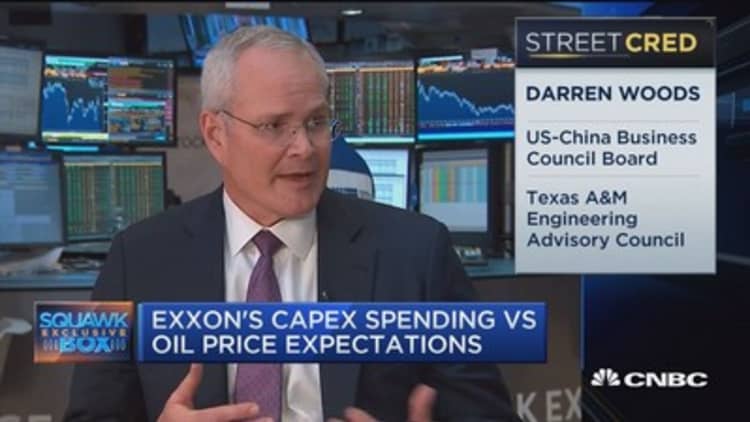
When Exxon Mobil's new CEO spoke to Wall Street this week, high on his list of growth opportunities were the nontraditional oil fields in the United States, where the diversified energy giant can make a profit even when crude prices are just $40 per barrel.
For the multinational Exxon, which invested globally in more expensive, deepwater and other long-term projects, the focus on its home base highlights how much U.S. oil majors see American production as a brighter part of the future.
A big chunk of Exxon's upstream spending will go to shale this year. "More than one third of the capex [capital and exploration spending] will be invested in advancing our large inventory of … short-cycle opportunities. They are primarily Permian and Bakken unconventional plays and short-cycle conventional work programs. This component of our investment plan is expected to generate positive cash flow less than three years after initial investment," CEO Darren Woods told analysts.
Woods' comments resonate across the U.S. oil sector, where domestic producers have been restarting operations as oil prices hold steadily in the $50-per-barrel range.
Producers large and small are also reassessing capital and exploration spending and cautiously returning to develop projects, but the U.S. shale industry has also become more efficient during the industry downturn.
"I think what you're seeing is the shale play was totally without majors," said Randy Foutch, founder and CEO of Laredo Petroleum, pointing back to a time years back when the majors were land holders but not such active players.
"Chevron has a big position in the Permian, and Exxon just bought a new position. That's the kind of proof of the pudding that the independents like myself are saying, 'It's the best basin the world.'" Laredo is active in the eastern part of the Permian, in the Midland Basin.
Like many in the industry, Foutch has found efficiencies during the oil-price downturn. In the last two years, drilling has improved so much, individual Laredo rigs are drilling 2.5 times more than they used to. "I don't think it's a question of getting back to the rig count we had. I would suggest we expand our activity more dramatically," he said.
Chevron says it has about 2 million net acres of resources in the Permian Basin, and Occidental Petroleum is also a big player. Independents Concho, Pioneer Natural Resources and Apache are also active there.
"The Permian has been around for a long, long time. It never left the stage, but its career has been relaunched. They understand the geology better, and there's a lot more oil to unlock there. It's the repercussion of the great revolution and the drilling that took place and everything that's been learned over the last decade. This is part of the reaction that we're seeing in the global oil market," said Jim Burkhard, vice president and head of oil market research at IHS Markit.
World energy summit
Foutch, Woods and other CEOs of majors and independents alike are heading to Houston next week for the annual CERAWeek by IHS Markit energy conference. Other speakers at the conference include the oil ministers of Saudi Arabia, India, Russia and Iraq, among others.
The Permian Basin in Texas is certainly expected to be a big topic. The Bakken in North Dakota is also making a comeback, but the promise of much more oil to come from the Permian has been the buzz of the oil industry this year. Earlier this year, Exxon bought about 225,000 net acres in the Permian from the Bass Brothers of Fort Worth.
Shale has also become the swing producer for global oil markets, and it is proving resilient with the swift return of U.S. production. The United States has produced more than 9 million barrels a day in the last several weeks, and IHS expects it to add back another 600,000 barrels a day by year end, bringing it close to its 2015 peak.
"It's Permian-ania," said Daniel Yergin, vice chairman of IHS Markit, of what is now the hottest basin in the United States.
Yergin said he expects the industry to discuss how it is increasing capital and exploration spending, but the word from CEOs of oil majors will likely be that the emphasis is on short-cycle versus long-cycle projects. "More prominent in this year's program will be that they are raising capex, but it's cautious," said Yergin.
"It [spending] really peaked in 2014 and then just plummeted. It's picking up cautiously. It's notably picked up in the U.S. It's mainly projects being completed,' Yergin said.
Exploration 2.0
Exxon, for instance, said it is slightly increasing capex spending from the $19 billion level in 2016, which was off sharply from $30 billion the year earlier. "In 2017 we expect to spend $22 billion. This allows us to advance investments and adjust, either up or down, to commodity prices, price conditions and cash flow. We anticipate the average annual budget through the end of the decade will be around $25 billion," Woods told analysts Wednesday.
Exxon Mobil has 5,500 wells in the Permian that return 10 percent or better, with oil at $40 per barrel. "A large chunk of those wells will make higher than 10 percent. ... It's a very prolific play. We're very excited about the opportunity in the Permian," Woods told CNBC.
Woods said the shale plays help add flexibility to Exxon's range of oil holdings. "Our view on the oil price is there's still a lot of uncertainty in the marketplace, so while we have seen prices go up in the short term, we're not building our investment campaign based on the assumption those prices are going to be there forever," he said. "One of the advantages we have with this recent acquisition that we did in the Permian is we have a much bigger portfolio of short-cycle investments. That gives us the flexibility to move as the market moves, and raise our investment levels up to match what we see as opportunities in the marketplace."
Exxon, which produces about 4 million barrels a day of oil equivalents, expects Permian and other shale plays to grow to about 800,000 barrels a day by 2025 from just under 200,000.
Chevron, which will also be at the CERAWeek conference, announced a fourth year of cuts in capital and exploration spending last December. It said of the $19.8 billion it will spend this year, about $8.5 billion of planned capital spending relates to base-producing assets, which includes about $2.5 billion for shale and tight investments, mostly in the Permian.
Future outlook
Credit Suisse analysts upgraded Exxon Thursday to neutral from underperform, a rating they gave the integrated major in 2014. They said they made the change on valuation, but they also noted its shale investment and said "the integration case is becoming more compelling as rapid growth of light shale molecules from the US need to find a home downstream."
Foutch said while the environment is getting better for producers, one issue for the industry is the potential for another price shakeout.
"I think part of my problem is we've seen too many times where there was a double dip. I don't want to be a pessimist but we're relying on OPEC and it's in their best interest to cut production, and we're relying on them. We've taken the United States from being [oil] dependent to having a huge amount of supply in a short amount of time," he said.
Oil prices began to rise and steadied late last year after OPEC members joined with non OPEC producers to cut back 1.8 million barrels a day of production, under a six-month agreement which can be extended.
Foutch said he's lived through boom and bust periods seven times before, five times while at the helm of a company he founded. When prices collapsed, Foutch already had a plan. U.S. oil prices bottomed in February, 2016 at about $26 per barrel.
"We did the same thing we always had done. We were well hedged and moved what debt we had out seven years. We didn't have short term debt…we were able to cut from nine rigs to three in a matter of months," he said. Laredo has since brought one of those rigs back on line, but Foutch said he's not in a hurry to restore them all.





